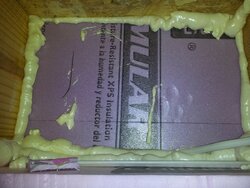I have a basement installed Napoleon 1900. The basement is not insulated and the front third is above grade. It is concrete block and I know I am losing a ton of heat this way. All that aside, I want to try and come up with the best way to heat my house with wood effectively.
Last year I had an old smoke dragon with a heat reclaimer on the stove pipe. This heated pretty well but murdered wood and created a lot of creosote. I now have an EPA stove and it seems to heat well, but I fear with colder weather coming I will not be able to heat with wood alone. The house is one story, about 1900 sq ft. I have tried pulling hot air off a plenum above the stove with an inline duct fan to feed into my living room. This works decently but only heats 1 room well and is also not up to code. I also tried forcing my oil burner fan to run, and running a cold air return line with one end open near the stove. This circulates air through the ducts, but the air is not warm at all. I am thinking that until it goes through the returns, back across the house to get pulled through the furnace, there is no heat left.
Please see my rudimentary drawing. Red lines are supply lines, blue are returns. If anyone has any good ideas I am all ears. I am considering getting an Englander Add on furnace and running it into my existing ductwork. But, I am not sure how this would work as the wood furnace would be on the other end of the oil furnace. The blower from the wood furnace would need to solely supply heated air to all of the ducts. Or else I could install new ducts to key rooms and only feed those with the wood furnace. Ideas?

Last year I had an old smoke dragon with a heat reclaimer on the stove pipe. This heated pretty well but murdered wood and created a lot of creosote. I now have an EPA stove and it seems to heat well, but I fear with colder weather coming I will not be able to heat with wood alone. The house is one story, about 1900 sq ft. I have tried pulling hot air off a plenum above the stove with an inline duct fan to feed into my living room. This works decently but only heats 1 room well and is also not up to code. I also tried forcing my oil burner fan to run, and running a cold air return line with one end open near the stove. This circulates air through the ducts, but the air is not warm at all. I am thinking that until it goes through the returns, back across the house to get pulled through the furnace, there is no heat left.
Please see my rudimentary drawing. Red lines are supply lines, blue are returns. If anyone has any good ideas I am all ears. I am considering getting an Englander Add on furnace and running it into my existing ductwork. But, I am not sure how this would work as the wood furnace would be on the other end of the oil furnace. The blower from the wood furnace would need to solely supply heated air to all of the ducts. Or else I could install new ducts to key rooms and only feed those with the wood furnace. Ideas?


 ... That is where your heat is going....
... That is where your heat is going.... 